How to Spot and Take Care of Your Newborn’s Rash
Medically reviewed by Daniel Combs, MD
Newborns commonly get skin rashes on various parts of their body. Most are harmless and resolve on their own. However, severe jaundice, eczema, or persistent diaper rash require medical intervention. Understanding the different types of newborn skin variations can help you know when to contact a healthcare provider.
This article covers common newborn rashes, how to treat them at home, and when to contact a healthcare provider.

d3sign / Getty Images
Common Rashes in Newborns
Newborns can have skin variations at birth or a few days after delivery. Common rashes in newborns include the following:
Pink pimples
Erythema toxicum
Milia
Salmon patches
Jaundice
Congenital melanocytosis
This section explores the causes and treatments for these common newborn rashes.
Pink Pimples
Pink pimples (newborn acne) are tiny red, pink, or white bumps that may appear on a baby’s face, chest, or back. They appear within the first few weeks of life in 30% of newborns. They are harmless and usually fade away within a few weeks. Gentle soap and water can help keep the baby’s skin clean.
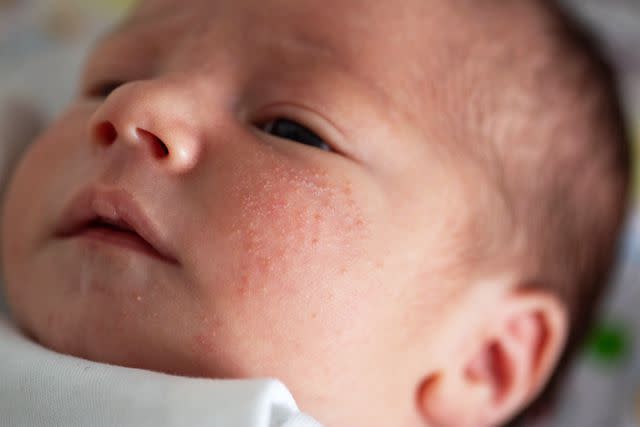
Henadzi Pechan / Getty Images
Erythema Toxicum
Erythema toxicum is red bumps (sometimes with pus or a red ring around them) on the baby's face, chest, back, and near the arms or legs. This rash affects 30% to 70% of newborns, typically in the first few days of life. It may cause mild irritation but usually resolves without treatment in about a week or two.
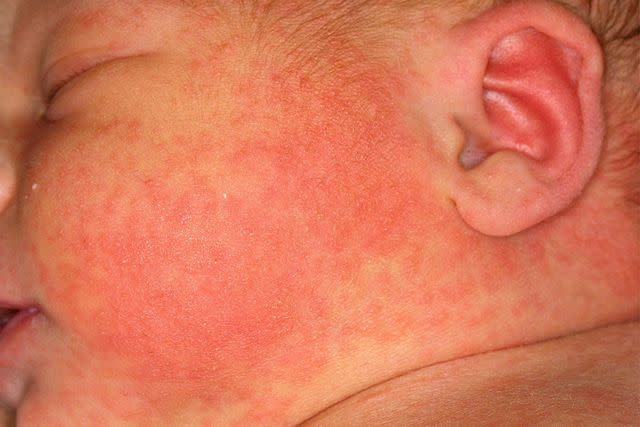
Reproduced with permission from © DermNet and © Raimo Suhonen dermnetnz.org 2023.
Milia
Milia (milk spots) are blocked oil glands that affect almost half of newborns. These small, white, or yellowish bumps can appear on a baby's nose, cheeks, forehead, or chin. They typically show up at birth, though premature babies might get them later.
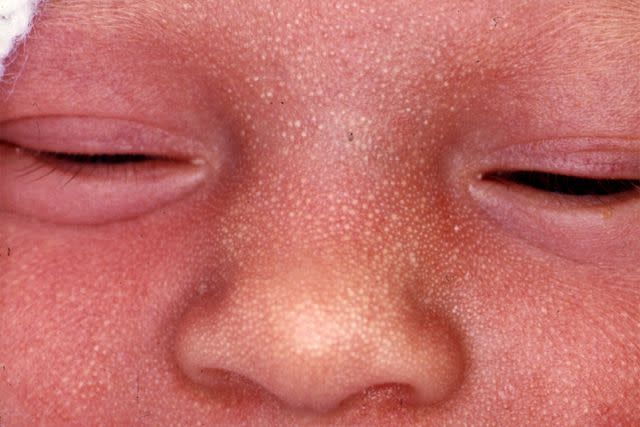
Reproduced with permission from © DermNet dermnetnz.org 2023.
Does My Baby Need Treatment for Milia?
Babies do not typically require treatment for milia. As the pores open, spots usually disappear on their own within a month or two. To prevent irritation, keep the baby's face clean with gentle soap and water and avoid squeezing or picking at the milia.
Salmon Patches (Nevus Simplex)
Salmon patches (nevus simplex) are flat, salmon (pink-orange), pink, or red birthmarks that appear in 30% to 40% of newborns. They do not cause discomfort and typically fade within a few months to a few years. Laser therapy can be an option if they don't go away. Depending on the location, you may hear people call these:
Stork bites: On the back of the neck
Angel kisses: Between the eyes
Salmon patches: Other parts of the body
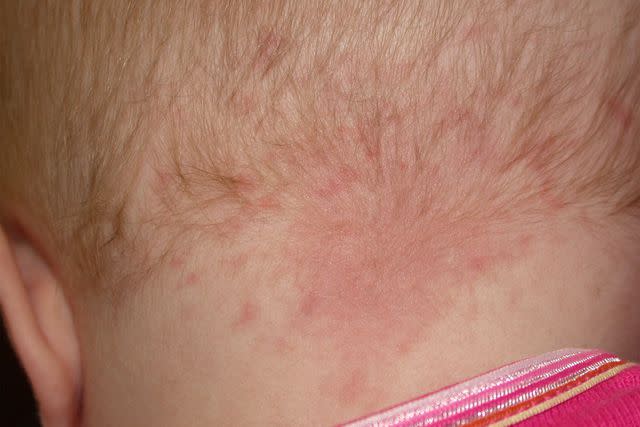
Reproduced with permission from © DermNet dermnetnz.org 2023.
Jaundice
Jaundice is the yellowing of the skin and whites of the eyes. Neonatal (newborn) jaundice can occur as the liver learns to clean out bilirubin (a specific type of waste) from the blood. It’s common and usually goes away on its own within a few weeks, but it’s important to tell the infant’s healthcare provider so they can monitor the baby.

Jaundice Treatment
Providers might suggest exposing the baby to sunlight for a short time. If the jaundice is severe, the baby might need special lights and fluids in the hospital to help eliminate the bilirubin.
Congenital Melanocytosis
Congenital melanocytosis is a harmless flat, gray-blue, blue-black, or bluish-green area that resembles a bruise. It typically appears at birth or within a few weeks on the back or buttocks of newborns with dark skin. It occurs when pigment-producing cells (melanocytes) are trapped deep in the skin. Congenial melanocytosis typically fades by school age.
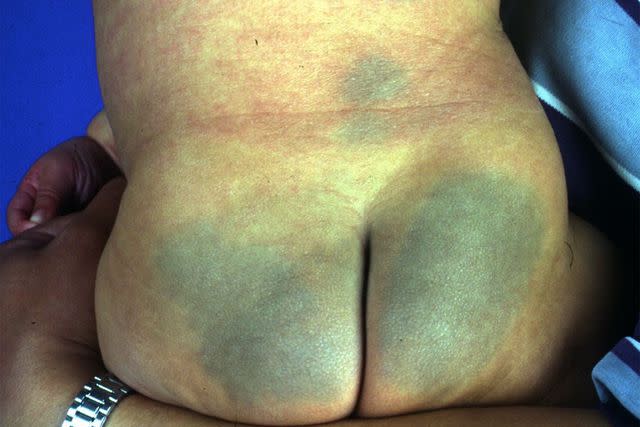
Reproduced with permission from © DermNet dermnetnz.org 2023.
Common Rashes in the First Few Months of Life
In the first few months of life, babies can develop rashes due to oil buildup, sensitive skin, eczema, irritants, heat, or infection.
Cradle Cap
Seborrheic dermatitis (cradle cap) causes red, scaly areas with greasy, yellow scales or dry, flaky patches due to oil and dead skin buildup. It can occur on the scalp, ears, face, and skin folds. Cradle cap affects around 10% of babies under 4 weeks old but is most common around 3 months.
Cradle cap is not harmful and usually gets better on its own. Baby oil can help reduce crusting before gently washing and brushing the baby's hair. If it persists, your provider may prescribe a cream or shampoo.
Eczema
Eczema (atopic dermatitis) makes the skin itchy, dry, and scaly, leading to red and swollen patches. It often starts on the cheeks and forehead before spreading to skin creases, elbows, and knees. Babies may scratch these areas, causing discomfort and bleeding, making it difficult for them to rest. About 60% of infants with eczema will have symptoms by age one. Babies with a family history of allergies are at higher risk of eczema.
Eczema Treatment
Infants with eczema often get allergies or asthma as they age. Treatment involves gentle skin care and avoiding triggers like harsh soaps, dry air, and pet dander. You can also use a cool washcloth or colloidal oatmeal in a lukewarm bath to reduce itching and swelling. In severe cases, a healthcare provider may suggest steroid creams.
Heat Rash
When sweat ducts clog, sweat leaks into the layers of the skin, causing a heat rash (miliaria). It affects up to 40% of infants, often in the first month of life. One of its two types causes tiny, clear blisters without redness in areas like the neck and underarms. The other causes small red bumps on the forehead, upper body, and covered areas that get hot.
Preventing and Treating Heat Rash
Dressing newborns in light clothes and keeping them cool during hot or humid weather can help prevent and treat heat rash.
Related: What a Heat Rash Looks Like on Darker Skin (and What to Do Next)
Diaper Dermatitis
Diaper dermatitis (diaper rash) leads to over a million clinic visits in the United States yearly. The wetness from urine and stool breaks down the skin's protective barrier, causing redness and discomfort. Some diapers, baby wipes, creams, or detergents can also irritate the diaper area.
Treatment involves keeping the area clean and dry and using diaper creams with minimal ingredients, which typically helps resolve the rash within a few days.
Fungal Infections
Persistent diaper rashes might result from fungi or yeast, causing itchy skin, with red or white dry or scaly patches, bumps, or blisters. Yeast infections often appear in moist, dark areas like the diaper area and skin folds. It can occur when babies or breastfeeding parents take antibiotics. Your provider may suggest an antifungal cream.
What Is a Rash On a Newborn's Chest?
Newborns can have chest rashes from drool, erythema toxicum, heat, eczema, or baby acne.
Related: How to Spot and Take Care of Your Baby’s Rash
When to Contact a Healthcare Provider
If your baby has a fever or seems sick, or if the rash is spreading rapidly, causing discomfort, or not improving, see a healthcare provider right away. Watch for signs of discomfort like ear pulling, tongue thrusting, fussiness, and clinginess. If your baby has hives (allergic rash) and difficulty breathing, call 911 immediately.
Summary
Newborn skin abnormalities and rashes are common and often harmless. They include baby acne, cradle cap, birthmarks, diaper rash, eczema, and heat rash. Most go away independently or with home care, but some may need treatment. Contact a healthcare provider if the baby seems uncomfortable and the rash worsens.
Read the original article on Verywell Health.

